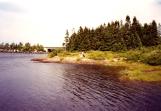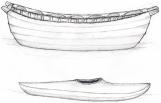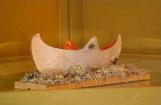14
Located in Bloody Bay Cove, the Quarry is one of the most significant sites in the area. So far the 'Burnside Heritage Foundation Inc.' has identified ten sites in this quarry alone. It is one of the largest aboriginal quarries found to date in Newfoundland. Arrowheads and other stone tools made from the Quarry's volcanic rhyolite have been found far from Bloody Bay. It is easy to see, in one's mind, aboriginal boats moving to and from this site, carrying the precious rhyolite that was so crucial for making tools and weapons.16
These artifacts come from Bloody Bay Cove. The one centimeter measurement in the picture indicates how small these Recent Indian artifacts really are: we can assume that they were very precise tools. Notice that the middle item is broken.17
Paleo Eskimo site at the mouth of the Terra Nova River2000
Terra Nova River, Glovertown, Newfoundland & Labrador, Canada

18
The site discovered at the mouth of the Terra Nova River shows that the Paleo Eskimo people lived in Glovertown thousands of years ago. One can easily imagine them traveling by boat up and down the beautiful Terra Nova River looking for wild game, especially caribou.20
These unfinished stone tools, found at the Terra Nova River site, were skillfully carved by Paleo Eskimos.22
A number of woodworking tools have been linked to the Maritime Archaic Indians suggesting that they were accomplished woodworkers. Thus, it is believed that this aboriginal group may have used dugout canoes.24
The Paleo Eskimos were very skilled hunters. They hunted a lot of mammals, mostly seals, and used the hide to cover their umiaks and kayaks.Umiaks, flat-bottomed boats, were built of driftwood and seal hides. Umiaks could carry up to twenty people and their belongings. According to the Newfoundland Encyclopedia, "When traveling, women rowed the umiaks with long, wooden oars, sometimes hoisting a square sail on a single mast. On hunting trips men used lighter, single-bladed paddles and a wooden rudder."
Kayaks are buoyant, hide-covered canoes. They are enclosed with the exception of a small opening for an individual. The men and women worked together in the building of their kayaks. The men concentrated on the carved driftwood frame and the women the hide covering. The women worked in groups so that the double stitching of the wet hides could be completed before they dried.
26
Recent Indians (Beaches, Little Passage, Beothuk) used birchbark canoes. There were two types of canoes: the rounded bottom used on the ocean and flat bottom used on rivers. These canoes were built in various shapes and sizes depending on their intended purposes. The Beothuk people, who depended on canoes for most of their transportation, were extremely skilled in boating. The rough rapids of the Terra Nova River did not deter them.Their canoes usually measured fourteen to twenty-four feet in length. The structure of both types was much the same: a black spruce inner frame and birch bark outer covering sewn with sinew, roots or other suitable local materials.




